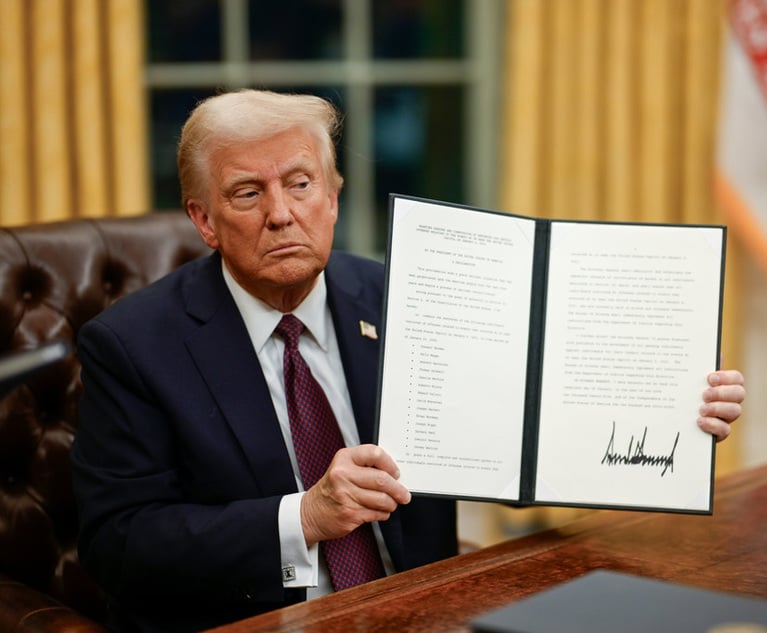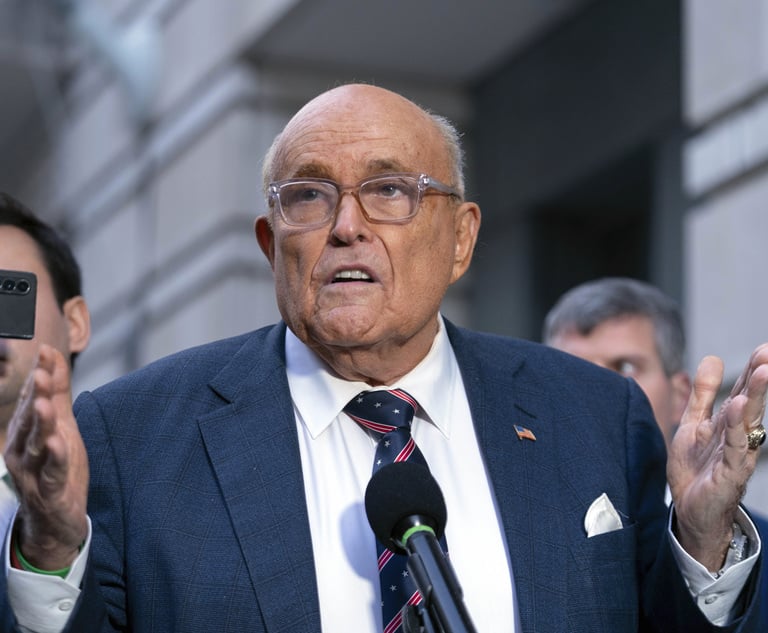 Credit: Vitalii Vodolazskyi/Adobe Stock
Credit: Vitalii Vodolazskyi/Adobe StockTrade Secret Litigation: How Will AI Innovations Likely Be Litigated?
While perhaps not as attention grabbing as those copyright cases, trade secret law—developed over decades through common law decisions and state and federal statutes—will likely be one of the key areas of law where stakeholders work to protect, or in some cases protect against, evolving AI technology.
November 14, 2024 at 12:34 PM
11 minute read
Advances in technology, and the inevitable litigation that follows, often unfold against a backdrop of long-standing laws—and artificial intelligence (or AI) will not be an exception. For an example of AI-related disputes being litigated under an established legal framework, one only has to look to the application of copyright laws largely in place for over a century to generative AI lawsuits brought by Sarah Silverman and other artists and media companies. See, e.g., Peter Brown, “ChatGPT May Be Threatening Your Copyrights and Privacy,” New York Law Journal, Aug. 7, 2023. While perhaps not as attention grabbing as those copyright cases, trade secret law—developed over decades through common law decisions and state and federal statutes—will likely be one of the key areas of law where stakeholders work to protect, or in some cases protect against, evolving AI technology.
This article examines the core elements of traditional trade secret misappropriation claims and their likely application to AI technology that continues to advance at seemingly warp speeds. Section I takes a practical approach to thinking about the definition of AI. Section II discusses the definition and requirements for establishing an enforceable “trade secret,” and how those requirements are likely to be applied with respect to AI innovations. Section III then discusses how one type of trade secret known as a “combination trade secret” could play a critical role in future AI-related trade secret litigation.
An Overview of Artificial Intelligence
Definitions of “artificial intelligence” continue to vary (and be debated), but AI commonly refers to computer systems that are capable of performing tasks that mimic human intelligence. See “The Artificial Intelligence Glossary,” Sept. 30, 2024, https://www.law.com/legaltechnews/2024/09/30/the-artificial-intelligence-glossary/. The term “artificial intelligence” also serves as something of an umbrella label encompassing a variety of more specific technologies, including machine learning and deep learning. Id. Unsurprisingly, AI technology can be inherently valuable, and can also drive practical use cases, including the following examples (recently discussed by the U.S. Patent and Trademark Office):
- Anomaly detection whereby the use of a neural network can identify or detect anomalies (and can be used in various industries like cybersecurity) (PTO Example 47).
- Speech separation in which AI technology analyzes speech signals and can separate desired speech from extraneous or background speech capable (PTO Example 48).
- Fibrosis treatment in which an AI model has been designed to assist in personalizing individual patient medical treatment. (PTO Example 49)
What makes the examples above, and many real world applications of AI challenging, is that the AI will likely be part of complex, multi-component systems of which some of the parts may already be known but where certain other components may be the “secret sauce” to the new, innovative AI feature. In this fast-paced setting, the protection of AI-related innovations presents a complex question: under what conditions will trade secret law be available and what issues are likely to get litigated?
NOT FOR REPRINT
© 2025 ALM Global, LLC, All Rights Reserved. Request academic re-use from www.copyright.com. All other uses, submit a request to [email protected]. For more information visit Asset & Logo Licensing.
You Might Like
View All

Rudy Giuliani's Story Arc in the Southern District of New York


You’re Sure You’ve Looked? The Use of Jackson Affidavits and Efforts to Locate Discovery Materials
8 minute readTrending Stories
- 1Uber Files RICO Suit Against Plaintiff-Side Firms Alleging Fraudulent Injury Claims
- 2The Law Firm Disrupted: Scrutinizing the Elephant More Than the Mouse
- 3Inherent Diminished Value Damages Unavailable to 3rd-Party Claimants, Court Says
- 4Pa. Defense Firm Sued by Client Over Ex-Eagles Player's $43.5M Med Mal Win
- 5Losses Mount at Morris Manning, but Departing Ex-Chair Stays Bullish About His Old Firm's Future
Who Got The Work
J. Brugh Lower of Gibbons has entered an appearance for industrial equipment supplier Devco Corporation in a pending trademark infringement lawsuit. The suit, accusing the defendant of selling knock-off Graco products, was filed Dec. 18 in New Jersey District Court by Rivkin Radler on behalf of Graco Inc. and Graco Minnesota. The case, assigned to U.S. District Judge Zahid N. Quraishi, is 3:24-cv-11294, Graco Inc. et al v. Devco Corporation.
Who Got The Work
Rebecca Maller-Stein and Kent A. Yalowitz of Arnold & Porter Kaye Scholer have entered their appearances for Hanaco Venture Capital and its executives, Lior Prosor and David Frankel, in a pending securities lawsuit. The action, filed on Dec. 24 in New York Southern District Court by Zell, Aron & Co. on behalf of Goldeneye Advisors, accuses the defendants of negligently and fraudulently managing the plaintiff's $1 million investment. The case, assigned to U.S. District Judge Vernon S. Broderick, is 1:24-cv-09918, Goldeneye Advisors, LLC v. Hanaco Venture Capital, Ltd. et al.
Who Got The Work
Attorneys from A&O Shearman has stepped in as defense counsel for Toronto-Dominion Bank and other defendants in a pending securities class action. The suit, filed Dec. 11 in New York Southern District Court by Bleichmar Fonti & Auld, accuses the defendants of concealing the bank's 'pervasive' deficiencies in regards to its compliance with the Bank Secrecy Act and the quality of its anti-money laundering controls. The case, assigned to U.S. District Judge Arun Subramanian, is 1:24-cv-09445, Gonzalez v. The Toronto-Dominion Bank et al.
Who Got The Work
Crown Castle International, a Pennsylvania company providing shared communications infrastructure, has turned to Luke D. Wolf of Gordon Rees Scully Mansukhani to fend off a pending breach-of-contract lawsuit. The court action, filed Nov. 25 in Michigan Eastern District Court by Hooper Hathaway PC on behalf of The Town Residences LLC, accuses Crown Castle of failing to transfer approximately $30,000 in utility payments from T-Mobile in breach of a roof-top lease and assignment agreement. The case, assigned to U.S. District Judge Susan K. Declercq, is 2:24-cv-13131, The Town Residences LLC v. T-Mobile US, Inc. et al.
Who Got The Work
Wilfred P. Coronato and Daniel M. Schwartz of McCarter & English have stepped in as defense counsel to Electrolux Home Products Inc. in a pending product liability lawsuit. The court action, filed Nov. 26 in New York Eastern District Court by Poulos Lopiccolo PC and Nagel Rice LLP on behalf of David Stern, alleges that the defendant's refrigerators’ drawers and shelving repeatedly break and fall apart within months after purchase. The case, assigned to U.S. District Judge Joan M. Azrack, is 2:24-cv-08204, Stern v. Electrolux Home Products, Inc.
Featured Firms
Law Offices of Gary Martin Hays & Associates, P.C.
(470) 294-1674
Law Offices of Mark E. Salomone
(857) 444-6468
Smith & Hassler
(713) 739-1250






